John Deere LT133, LT155, LT166 Technical Manual
LT133, LT155 & LT166
Lawn Tractors
TECHNICAL
MANUAL
John Deere
Worldwide Commercial and
Consumer Equipment Division
TM1695 (20Sep00)
Replaces TM1695 (15Sep98)
Litho in U.S.A
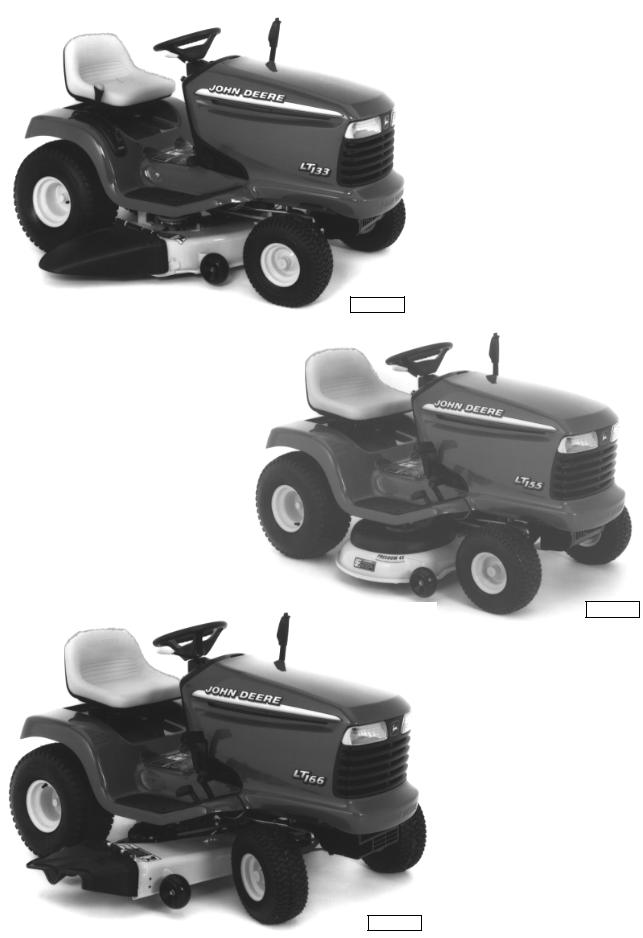
M85699
M85700
M85701
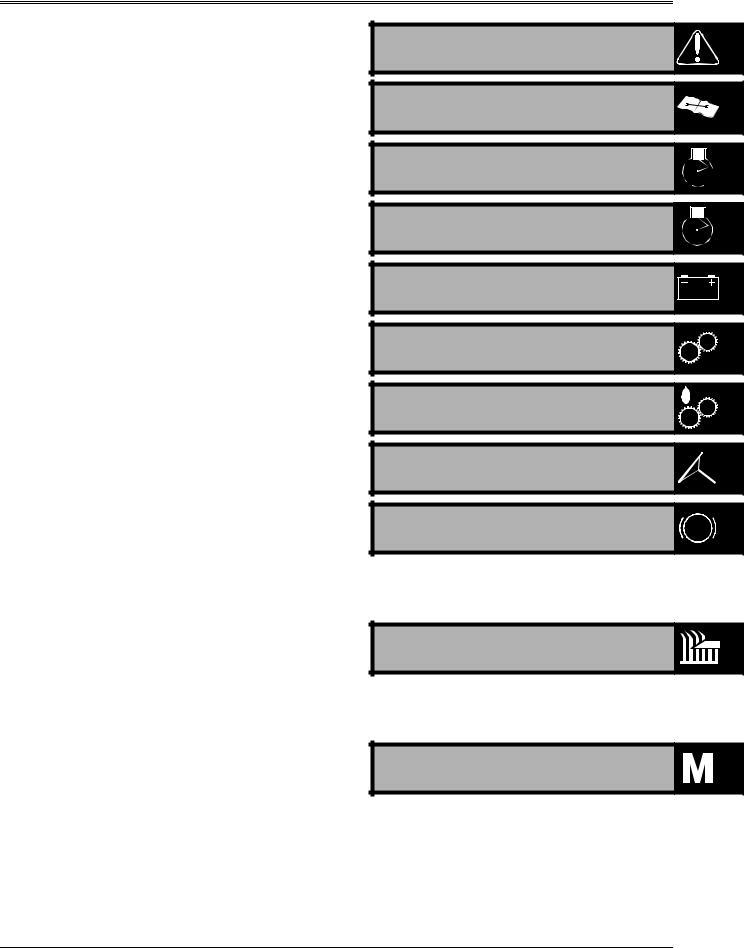
INTRODUCTION
This technical manual is written for an experienced technician and contains sections that are specifically for this product. It is a part of a total product support program.
Safety
The manual is organized so that all the information on a particular system is kept together. The order of grouping is as follows:
•Table of Contents
•General Diagnostic Information
•Specifications
•Electrical Wiring Harness Legend
•Component Location
•System Schematic
•Wiring Harness
•Troubleshooting Chart
•Theory of Operation
•Diagnostics
•Tests & Adjustments
•Repair
Note: Depending on the particular section or system being covered, not all of the above groups may be used.
Specifications and |
Information |
Kohler Engines
Briggs & Stratton Engine |
Electrical
Power Train (Gear)
Power Train (Hydrostatic)
Each section will be identified with a symbol rather than a number. The groups and pages within a section will be consecutively numbered.
We appreciate your input on this manual. To help, there are postage paid post cards included at the back. If you find any errors or want to comment on the layout of the manual please fill out one of the cards and mail it back to us.
All information, illustrations and specifications in this manual are based on the latest information available at the time of publication. The right is reserved to make changes at any time without notice.
COPYRIGHT© 2000
Deere and Co.
John Deere Worldwide Commercial and
Consumer Equipment Division
Horicon, WI
All rights reserved
Steering |
Brakes
Attachments
Miscellaneous
9/25/00 |
1 - 1 |
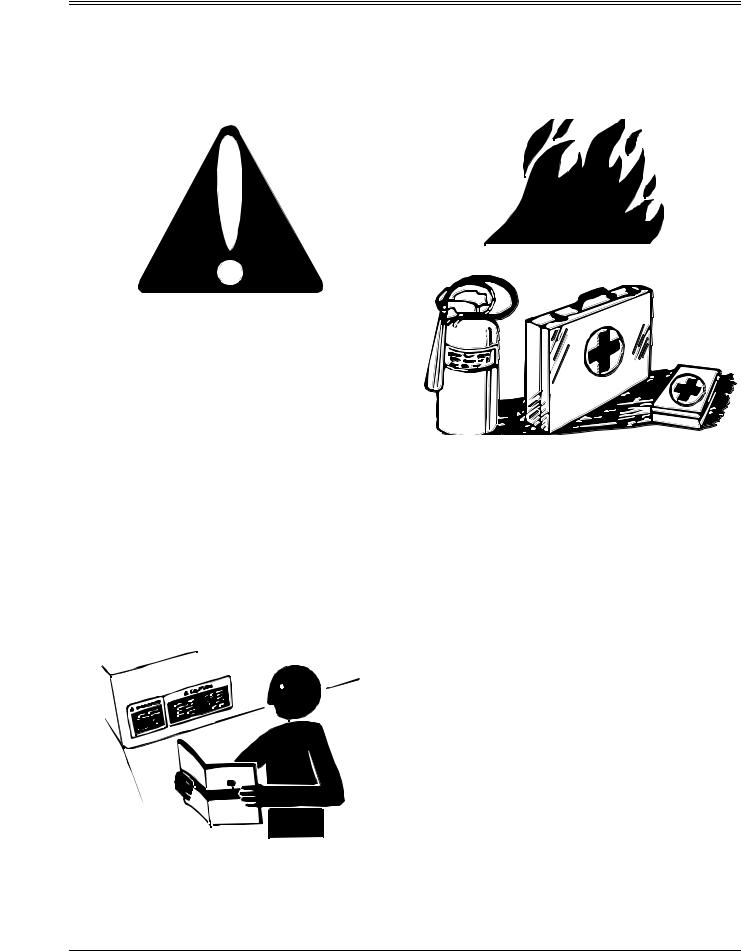
SAFETY
|
SAFETY |
HANDLE FLUIDS SAFELY-AVOID |
|
|
FIRES |
|
RECOGNIZE SAFETY INFORMATION |
BE PREPARED FOR EMERGENCIES |
|
||
|
|
This is the safety-alert symbol. When you see this symbol on your machine or in this manual, be alert to the potential for personal injury.
Follow recommended precautions and safe servicing practices.
UNDERSTAND SIGNAL WORDS
A signal word—DANGER, WARNING, or CAUTION—is used with the safety-alert symbol. DANGER identifies the most serious hazards.
DANGER or WARNING safety signs are located near specific hazards. General precautions are listed on CAUTION safety signs. CAUTION also calls attention to safety messages in this manual.
REPLACE SAFETY SIGNS
Replace missing or damaged safety signs. See the machine operator’s manual for correct safety sign placement.
When you work around fuel, do not smoke or work near heaters or other fire hazards.
Store flammable fluids away from fire hazards. Do not incinerate or puncture pressurized containers.
Make sure machine is clean of trash, grease, and debris.
Do not store oily rags; they can ignite and burn spontaneously.
Be prepared if a fire starts.
Keep a first aid kit and fire extinguisher handy.
Keep emergency numbers for doctors, ambulance service, hospital, and fire department near your telephone.
1 - 2 |
9/25/00 |
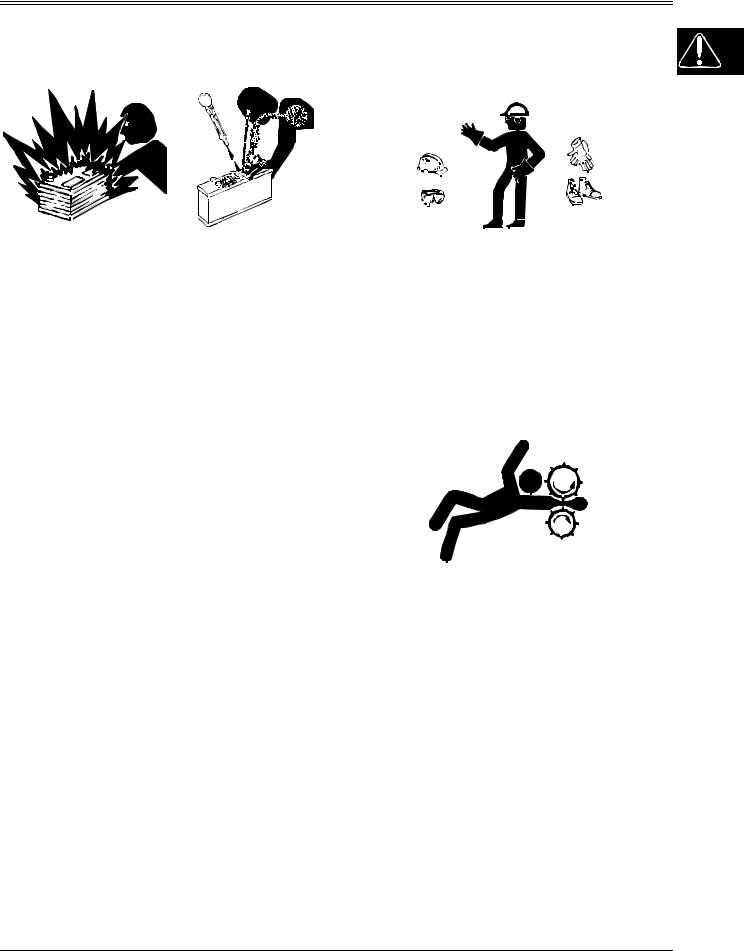
SAFETY
USE CARE IN HANDLING AND SERVICING BATTERIES
PREVENT BATTERY EXPLOSIONS
•Keep sparks, lighted matches, and open flame away from the top of battery. Battery gas can explode.
•Never check battery charge by placing a metal object across the posts. Use a volt-meter or hydrometer.
•Do not charge a frozen battery; it may explode. Warm battery to 16°C (60°F).
PREVENT ACID BURNS
•Sulfuric acid in battery electrolyte is poisonous. It is strong enough to burn skin, eat holes in clothing, and cause blindness if splashed into eyes.
•Avoid acid burns by:
1.Filling batteries in a well-ventilated area.
2.Wearing eye protection and rubber gloves.
3.Avoiding breathing fumes when electrolyte is added.
4.Avoiding spilling or dripping electrolyte.
5.Use proper jump start procedure.
•If you spill acid on yourself:
1.Flush your skin with water.
2.Apply baking soda or lime to help neutralize the acid.
3.Flush your eyes with water for 10_15 minutes.
4.Get medical attention immediately.
•If acid is swallowed:
1.Drink large amounts of water or milk.
2.Then drink milk of magnesia, beaten eggs, or vegetable oil.
3.Get medical attention immediately.
USE SAFE SERVICE PROCEDURES
WEAR PROTECTIVE CLOTHING
Wear close fitting clothing and safety equipment appropriate to the job.
Prolonged exposure to loud noise can cause impairment or loss of hearing. Wear a suitable hearing protective device such as earmuffs or earplugs to protect against objectionable or uncomfortable loud noises.
Operating equipment safely requires the full attention of the operator. Do not wear radio or music headphones while operating machine.
SERVICE MACHINES SAFELY
Tie long hair behind your head. Do not wear a necktie, scarf, loose clothing, or necklace when you work near machine tools or moving parts. If these items were to get caught, severe injury could result.
Remove rings and other jewelry to prevent electrical shorts and entanglement in moving parts.
USE PROPER TOOLS
Use tools appropriate to the work. Makeshift tools and procedures can create safety hazards. Use power tools only to loosen threaded parts and fasteners. For loosening and tightening hardware, use the correct size tools. DO NOT use U.S. measurement tools on metric fasteners. Avoid bodily injury caused by slipping wrenches. Use only service parts meeting John Deere specifications.
9/25/00 |
1 - 3 |
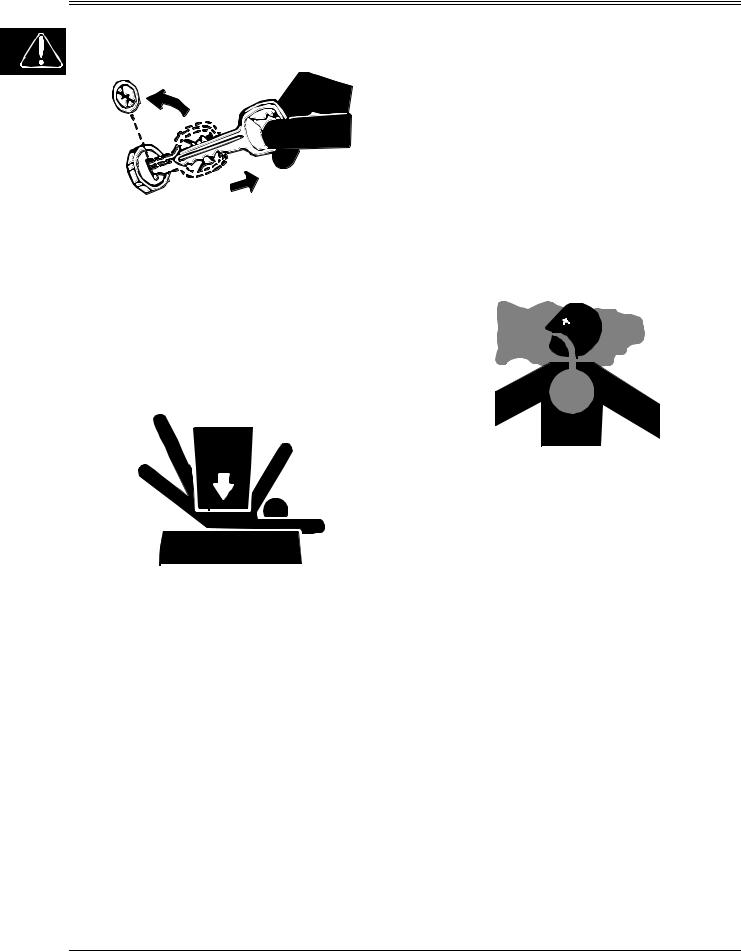
SAFETY
PARK MACHINE SAFELY |
USING HIGH PRESSURE WASHERS |
|
Directing pressurized water at electronic/electrical com- |
|
ponents or connectors, bearings, hydraulic seals, fuel |
|
injection pumps or other sensitive parts and compo- |
|
nents may cause product malfunctions. Reduce pres- |
|
sure and spray at a 45 to 90 degree angle. |
Before working on the machine:
1.Lower all equipment to the ground.
2.Stop the engine and remove the key.
3.Disconnect the battery ground strap.
4.Hang a “DO NOT OPERATE” tag in operator station.
SUPPORT MACHINE PROPERLY AND USE PROPER LIFTING EQUIPMENT
ILLUMINATE WORK AREA SAFELY
Illuminate your work area adequately but safely. Use a portable safety light for working inside or under the machine. Make sure the bulb is enclosed by a wire cage. The hot filament of an accidentally broken bulb can ignite spilled fuel or oil.
WORK IN VENTILATED AREA
Engine exhaust fumes can cause sickness or death. If it is necessary to run an engine in an enclosed area, remove the exhaust fumes from the area with an exhaust pipe extension.
If you do not have an exhaust pipe extension, open the doors and get outside air into the area.
If you must work on a lifted machine or attachment, securely support the machine or attachment.
Do not support the machine on cinder blocks, hollow tiles, or props that may crumble under continuous load. Do not work under a machine that is supported solely by a jack. Follow recommended procedures in this manual. Lifting heavy components incorrectly can cause severe injury or machine damage. Follow recommended procedure for removal and installation of components in the manual.
WORK IN CLEAN AREA
Before starting a job:
1.Clean work area and machine.
2.Make sure you have all necessary tools to do your job.
3.Have the right parts on hand.
4.Read all instructions thoroughly; do not attempt shortcuts.
WARNING: CALIFORNIA PROPOSITION 65 WARNING
Gasoline engine exhaust from this product contains chemicals known to the State of California to cause cancer, birth defects, or other reproductive harm.
REMOVE PAINT BEFORE WELDING OR HEATING
Avoid potentially toxic fumes and dust. Hazardous fumes can be generated when paint is heated by welding, soldering, or using a torch. Do all work outside or in a well ventilated area. Dispose of paint and solvent properly. Remove paint before welding or heating: If you sand or grind paint, avoid breathing the dust. Wear an approved respirator. If you use solvent or paint stripper, remove stripper with soap and water before welding. Remove solvent or paint stripper containers and other flammable material from area. Allow fumes to disperse at least 15 minutes before welding or heating.
1 - 4 |
9/25/00 |
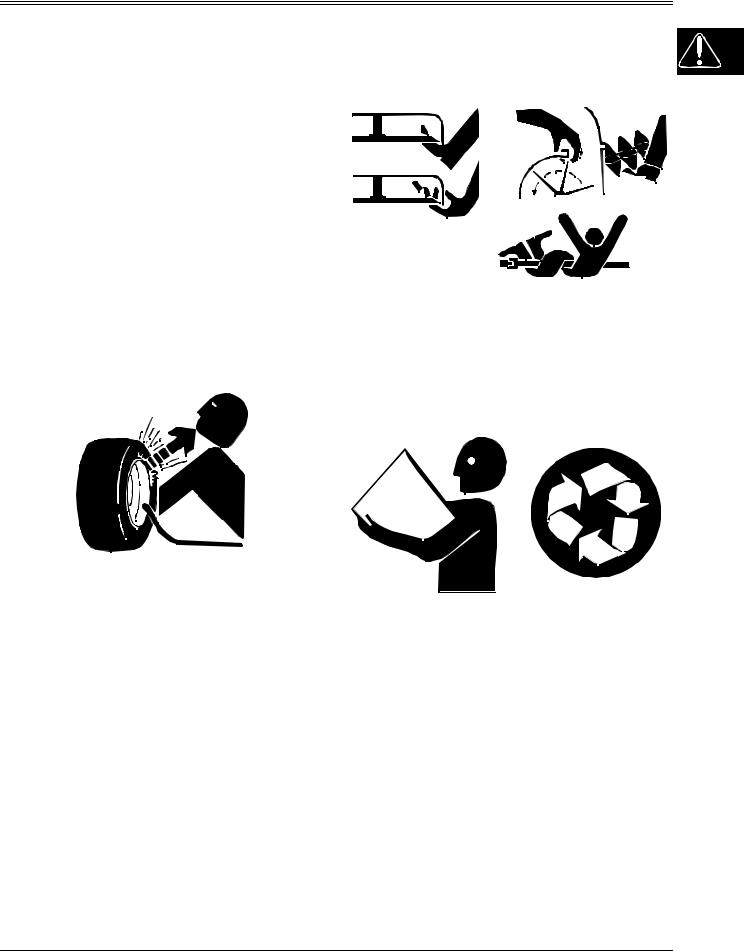
SAFETY
AVOID HARMFUL ASBESTOS DUST
Avoid breathing dust that may be generated when handling components containing asbestos fibers. Inhaled asbestos fibers may cause lung cancer.
Components in products that may contain asbestos fibers are brake pads, brake band and lining assemblies, clutch plates, and some gaskets. The asbestos used in these components is usually found in a resin or sealed in some way. Normal handling is not hazardous as long as airborne dust containing asbestos is not generated.
Avoid creating dust. Never use compressed air for cleaning. Avoid brushing or grinding material containing asbestos. When servicing, wear an approved respirator. A special vacuum cleaner is recommended to clean asbestos. If not available, apply a mist of oil or water on the material containing asbestos. Keep bystanders away from the area.
SERVICE TIRES SAFELY
Explosive separation of a tire and rim parts can cause serious injury or death.
Do not attempt to mount a tire unless you have the proper equipment and experience to perform the job. Always maintain the correct tire pressure. Do not inflate the tires above the recommended pressure. Never weld or heat a wheel and tire assembly. The heat can cause an increase in air pressure resulting in a tire explosion. Welding can structurally weaken or deform the wheel. When inflating tires, use a clip-on chuck and extension hose long enough to allow you to stand to one side and NOT in front of or over the tire assembly. Use a safety cage if available.
Check wheels for low pressure, cuts, bubbles, damaged rims or missing lug bolts and nuts.
AVOID INJURY FROM ROTATING
BLADES, AUGERS AND PTO
SHAFTS
Keep hands and feet away while machine is running. Shut off power to service, lubricate or remove mower blades, augers or PTO shafts.
HANDLE CHEMICAL PRODUCTS
SAFELY
Direct exposure to hazardous chemicals can cause serious injury. Potentially hazardous chemicals used with John Deere equipment include such items as lubricants, coolants, paints, and adhesives.
A Material Safety Data Sheet (MSDS) provides specific details on chemical products: physical and health hazards, safety procedures, and emergency response techniques. Check the MSDS before you start any job using a hazardous chemical. That way you will know exactly what the risks are and how to do the job safely. Then follow procedures and recommended equipment.
9/25/00 |
1 - 5 |
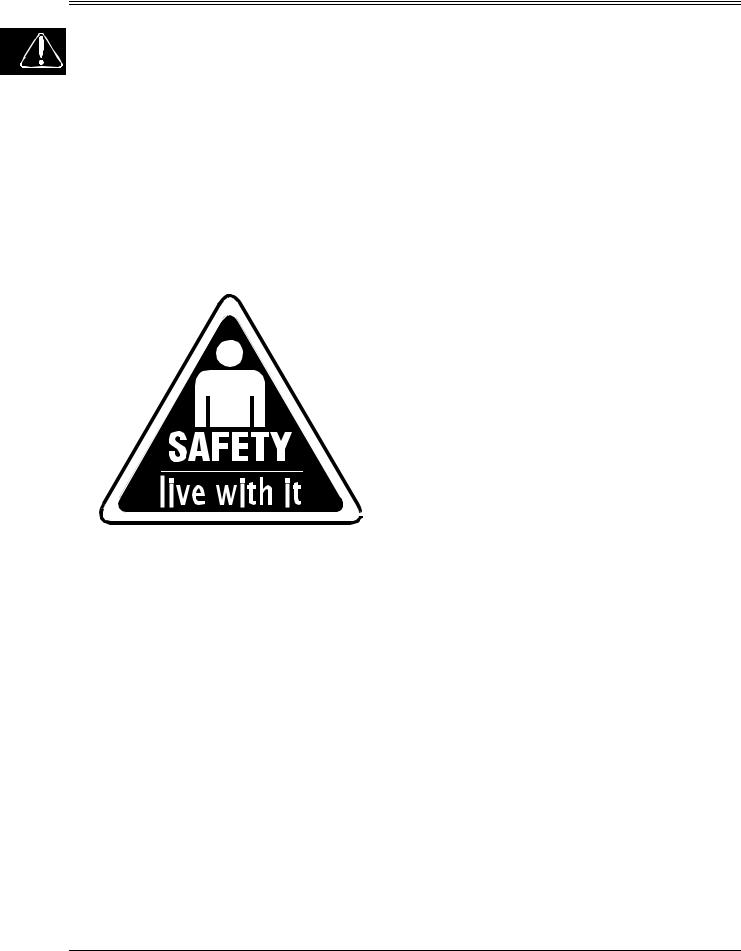
SAFETY
DISPOSE OF WASTE PROPERLY
Improperly disposing of waste can threaten the environment and ecology. Potentially harmful waste used with John Deere equipment include such items as oil, fuel, coolant, brake fluid, filters, and batteries. Use leakproof containers when draining fluids. Do not use food or beverage containers that may mislead someone into drinking from them. Do not pour waste onto the ground, down a drain, or into any water source. Inquire on the proper way to recycle or dispose of waste from your local environmental or recycling center, or from your John Deere dealer.
LIVE WITH SAFETY
Before returning machine to customer, make sure machine is functioning properly, especially the safety systems. Install all guards and shields.
1 - 6 |
9/25/00 |

SPECIFICATIONS AND INFORMATION |
CONTENTS |
|
|
|
|
CONTENTS
Page
SPECIFICATIONS
GENERAL VEHICLE SPECIFICATIONS . . . . . . . . . . . . . . . . . . . . . . . . . 3
METRIC FASTENER TORQUE VALUES . . . . . . . . . . . . . . . . . . . . . . . . . . . . . . . . . . 6 METRIC FASTENER TORQUE VALUE—GRADE 7 . . . . . . . . . . . . . . . . . . . . . . . . . . 7 INCH FASTENER TORQUE VALUES . . . . . . . . . . . . . . . . . . . . . . . . . . . . . . . . . . . . . 8
GASOLINE . . . . . . . . . . . . . . . . . . . . . . . . . . . . . . . . . . . . . . . . . . . . . . . . 9
GASOLINE STORAGE . . . . . . . . . . . . . . . . . . . . . . . . . . . . . . . . . . . . . . . . . . . . . . . . 9
LUBRICANTS . . . . . . . . . . . . . . . . . . . . . . . . . . . . . . . . . . . . . . . . . . . . . 10
ENGINE OIL - KOHLER ENGINE . . . . . . . . . . . . . . . . . . . . . . . . . . . . . . . . . . . . . . . 10 ENGINE OIL - BRIGGS & STRATTON ENGINE . . . . . . . . . . . . . . . . . . . . . . . . . . . . 10 ENGINE BREAK–IN OIL . . . . . . . . . . . . . . . . . . . . . . . . . . . . . . . . . . . . . . . . . . . . . . 11 ANTI-CORROSION GREASE . . . . . . . . . . . . . . . . . . . . . . . . . . . . . . . . . . . . . . . . . . 11 ALTERNATIVE LUBRICANTS . . . . . . . . . . . . . . . . . . . . . . . . . . . . . . . . . . . . . . . . . . 12 SYNTHETIC LUBRICANTS. . . . . . . . . . . . . . . . . . . . . . . . . . . . . . . . . . . . . . . . . . . . 12 LUBRICANT STORAGE . . . . . . . . . . . . . . . . . . . . . . . . . . . . . . . . . . . . . . . . . . . . . . 12 MIXING OF LUBRICANTS . . . . . . . . . . . . . . . . . . . . . . . . . . . . . . . . . . . . . . . . . . . . 12 CHASSIS GREASE . . . . . . . . . . . . . . . . . . . . . . . . . . . . . . . . . . . . . . . . . . . . . . . . . . 12 GEAR TRANSMISSION GREASE . . . . . . . . . . . . . . . . . . . . . . . . . . . . . . . . . . . . . . 13 HYDROSTATIC TRANSMISSION OIL. . . . . . . . . . . . . . . . . . . . . . . . . . . . . . . . . . . . 13
SERIAL NUMBER LOCATION . . . . . . . . . . . . . . . . . . . . . . . . . . . . . . . . 14
9/25/00 |
2 - 1 |

|
|
NOTES |
SPECIFICATIONS AND INFORMATION |
|
|
|
|
|
|
|
|
|
|
|
|
|
|
|
|
2 - 2 |
9/25/00 |

SPECIFICATIONS AND INFORMATION |
GENERAL VEHICLE SPECIFICATIONS |
|
|
|
|
GENERAL VEHICLE SPECIFICATIONS
ENGINE SPECIFICATIONS
KOHLER ENGINES—LT133 and LT155
Make . . . . . . . . . . . . . . . . . . . . . . . . . . . . . . . . . . . . . . . . . . . . . . . . . . . . . . . . . . . Kohler
Model / Model Number:
LT133. . . . . . . . . . . . . . . . . . . . . . . . . . . . . . . . . . . . . . . Command LT / CV13S-21525
LT155. . . . . . . . . . . . . . . . . . . . . . . . . . . . . . . . . . . . Command 15 QT / CV15S-41562
Power:
LT133. . . . . . . . . . . . . . . . . . . . . . . . . . . . . . . . . . . . . . . . . . . . . . . . . 9.7 kW (13.0 hp)
LT155. . . . . . . . . . . . . . . . . . . . . . . . . . . . . . . . . . . . . . . . . . . . . . . . 11.2 kW (15.0 hp)
Displacement:
LT133. . . . . . . . . . . . . . . . . . . . . . . . . . . . . . . . . . . . . . . . . . . . . .398 cm3 (24.3 cu-in.)
LT155. . . . . . . . . . . . . . . . . . . . . . . . . . . . . . . . . . . . . . . . . . . . . .426 cm3 (26.0 cu-in.)
Cylinders . . . . . . . . . . . . . . . . . . . . . . . . . . . . . . . . . . . . . . . . . . . . . . . . . . . . . . . . . . . . 1
Stroke/Cycle . . . . . . . . . . . . . . . . . . . . . . . . . . . . . . . . . . . . . . . . . . . . . . . . . . . . . . . . . 4
Valves . . . . . . . . . . . . . . . . . . . . . . . . . . . . . . . . . . . . . . . . . . . . . . . . . . Overhead Valves
Lubrication. . . . . . . . . . . . . . . . . . . . . . . . . . . . . . . . . . . . . . . . . . . . . . . . . . . Pressurized
Oil Filter. . . . . . . . . . . . . . . . . . . . . . . . . . . . . . Single Element, Full Flow, Spin-On Filter
Crankcase Capacity (With Filter) . . . . . . . . . . . . . . . . . . . . . . . . . . . . . . . . 1.8 L (1.9 qt)
Without Filter . . . . . . . . . . . . . . . . . . . . . . . . . . . . . . . . . . . . . . . . . . . . . . 1.4 L (1.5 qt)
Cooling System . . . . . . . . . . . . . . . . . . . . . . . . . . . . . . . . . . . . . . . . . . . . . . . . Air Cooled
Air Cleaner . . . . . . . . . . . . . . . . . . . . . . . . . . . . . . . . . . . Paper with outer foam element
Muffler . . . . . . . . . . . . . . . . . . . . . . . . . . . . . . . . . . . . . Horizontal discharge below frame
Spark Plug Gap. . . . . . . . . . . . . . . . . . . . . . . . . . . . . . . . . . . . . . . . . . 1.0 mm (0.040 in.)
BRIGGS & STRATTON—LT166
Make . . . . . . . . . . . . . . . . . . . . . . . . . . . . . . . . . . . . . . . . . . . . . . . . . . . Briggs & Stratton
Series . . . . . . . . . . . . . . . . . . . . . . . . . . . . . . . . . . . . . . . . . . . . . . . . . . Vanguard V-Twin
Type. . . . . . . . . . . . . . . . . . . . . . . . . . . . . . . . . . . . . . . . . . . . . . . . . . . . 916928 Gasoline
Model . . . . . . . . . . . . . . . . . . . . . . . . . . . . . . . . . . . . . . . . . . . . . . . . . . . . . . . . . 303777
Horsepower . . . . . . . . . . . . . . . . . . . . . . . . . . . . . . . . . . . . . . . . . . . . . 11.9 kW (16.0 hp)
Displacement . . . . . . . . . . . . . . . . . . . . . . . . . . . . . . . . . . . . . . . . 480 cm3 (29.3 cu. in.)
Cylinders . . . . . . . . . . . . . . . . . . . . . . . . . . . . . . . . . . . . . . . . . . . . . . . . . . . . . . . . . . . . 2
Stroke/Cycle . . . . . . . . . . . . . . . . . . . . . . . . . . . . . . . . . . . . . . . . . . . . . . . . . . . . . . . . . 4
Valves . . . . . . . . . . . . . . . . . . . . . . . . . . . . . . . . . . . . . . . . . . . . . . . . . . Overhead Valves
Lubrication. . . . . . . . . . . . . . . . . . . . . . . . . . . . . . . . . . . . . . . . . . . . . . . . . . . Pressurized
Oil Filter. . . . . . . . . . . . . . . . . . . . . . . . . . . . . . . . . . Full Flow Filter (w/o By-Pass Valve)
Crankcase Capacity (With Filter) . . . . . . . . . . . . . . . . . . . . . . . . . . . . . . . . 1.5 L (1.6 qt)
Without Filter . . . . . . . . . . . . . . . . . . . . . . . . . . . . . . . . . . . . . . . . . . . . . . 1.4 L (1.5 qt)
Cooling System . . . . . . . . . . . . . . . . . . . . . . . . . . . . . . . . . . . . . . . . . . . . . . . . Air Cooled
Air Cleaner . . . . . . . . . . . . . . . . . . . . . . . . . . . . . . . . . . . Paper with outer foam element
Muffler . . . . . . . . . . . . . . . . . . . . . . . . . . . . . . . . . . . . . Horizontal discharge below frame
Spark Plug Gap. . . . . . . . . . . . . . . . . . . . . . . . . . . . . . . . . . . . . . . . . . 1.0 mm (0.040 in.)
ELECTRICAL
Ignition. . . . . . . . . . . . . . . . . . . . . . . . . . . .Electronic Capacitor Discharge Ignition (CDI)
Type of Starter. . . . . . . . . . . . . . . . . . . . . . . . . . . . . . . . . . . . . . . . . . . . . . . . . . . . Bendix
Charging System. . . . . . . . . . . . . . . . . . . . . . . . . . . . . . . . . . . . . . . . Flywheel Alternator
9/25/00 |
2 - 3 |
